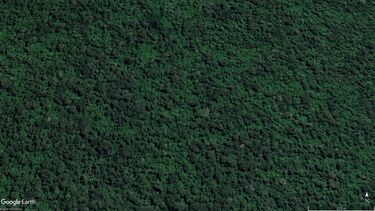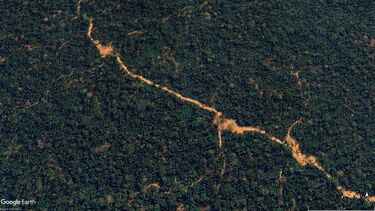- New technology developed by the University of ļý¬ę”į“Ķ uses satellite data to detect subtle changes in the rainforest canopy in near real-time, to provide evidence for the removal of the rainforests most valuable trees
- The independent forestry commission in Peru says the technology has so far been responsible for identifying as much as 37 per cent of all reported illegal logging across 1.8 million hectares of its rainforests
- Between 2023 and 2024, use of the tools led to the seizure of over 41,000 m3 of illegal wood, with a market value of in excess of US$19 Million.
- Peru’s rainforests play a crucial role in the fight against climate change, storing vast amounts of carbon and supporting an abundance of biodiversity
New technology is helping Peru fight against the illegal logging of its 68 million hectares of valuable tropical rainforest.
Developed by the University of ļý¬ę”į“Ķ, the technology uses satellite data to detect subtle changes in the rainforest canopy in near real-time, to provide evidence for the removal of the rainforests most valuable trees
Peru‚Äôs independent forestry commission (OSINFOR) says the technology, developed by the ļý¬ę”į“Ķ team, has so far been responsible for identifying as much as 37 per cent of all reported illegal logging across 1.8 million hectares of its rainforests.
Between 2023 and 2024, use of the tools led to the seizure of over 41,000 m3 of illegal wood, with a market value of in excess of US$19 Million.
Wood from rainforests is primarily sourced by selective logging, a technique which removes the most valuable trees from the forest, leaving the rest of the forest intact. Selective logging occurs in up to 400 million hectares of tropical forest worldwide, an area the size of the EU.
However, because selective logging doesn’t fell large areas of forest indiscriminately, locating and identifying areas where it is happening illegally can be difficult to do from the air, and it takes extraordinary amounts of resources to monitor the forests on foot or with drones, which can also be dangerous.
Peru’s rainforests form one of the most biodiverse regions of the planet and have a crucial role to play in combating climate change, yet illegal selective logging has led to the removal of some of the forest's most valuable and ecologically important trees for export and sale on the global timber markets.
So a team from the University of ļý¬ę”į“Ķ‚Äôs Grantham Centre for Sustainable Futures, including Professor Shaun Quegan, from the University of ļý¬ę”į“Ķ‚Äôs School of Mathematical and Physical Sciences and Professor David Edwards, from the School of Biosciences (now University of Cambridge), designed digital tools which use a machine learning approach to accurately detect the removal of individual trees. These can be used to assess forest degradation and provide evidence of selective logging and tree canopy loss.
The team worked with the World Resources Institute, a world leader in global forest monitoring, to develop the tools for use by the government of Peru to extend its protection and management of the country’s rainforest.
Dr Robert Bryant, from the University of ļý¬ę”į“Ķ‚Äôs School of Geography and Planning, said: ‚Äúļý¬ę”į“Ķ has a long and successful track record of using Earth Observation data to monitor the earth‚Äôs surface and find solutions to some of the world‚Äôs most pressing global conservation challenges.
“Until now satellite imaging has been unable to reliably identify the much more subtle signs of selective logging and forest degradation which is widespread, and until recently hard to police and manage. In Peru, extensive resources are needed to monitor the millions of hectares of rainforest and provide effective forest management and protection, especially for key endangered species at risk of international trade under the Convention on International Trade in Endangered Species of Wild Fauna and Flora (CITES).
“So using pre- and post-logging imagery from Amata Brazil, a forest management company - we developed a bespoke machine learning tool that could identify each instance of selective logging.
‚ÄúNow we are able to use the algorithm to identify protected forests that are being illegally harvested, and where concessions that are legally granted remain unharvested or under-harvested, but are reporting extensive harvest to launder and cover up illegal logging elsewhere.‚ÄĚ
Development of the tools for OSINFOR means that they can now be used to track illegal logging in near real-time. Once areas are identified, officials can also send drones, or personnel on foot to the gaps to confirm whether illegal logging has taken place, and check shipments of lumber that look suspicious.
The tools are helping Peru prosecute offenders, leverage fines and build capacity to fight the illegal logging that is a real threat to the valuable rainforest.
The new technology has significantly increased Peru’s ability to monitor the rainforests and has led to a drastic increase in their ability to prosecute for illegal selective logging. OSINFOR now plans to use the tools to expand their monitoring capabilities as part of its ongoing work with local agencies and local teams to deter illegal logging behaviours, and protect and conserve the rainforest.
Williams Arellano, Chief of OSINFOR, said: ‚ÄúWe are all committed to the sustainability of the Peruvian Amazon forests. Recently, two Peruvian specialists travelled to England to learn about this new technology and their experience is already being implemented in our agency for the effective and timely monitoring of forest resources. Thus, in July we will be ready to inaugurate, together with the ļý¬ę”į“Ķ experts, this new and innovative technology in Peru.‚ÄĚ
Dr Chris Bousfield, from the University of ļý¬ę”į“Ķ‚Äôs School of Biosciences, said: ‚ÄúWidespread illegal harvesting of Peru‚Äôs rainforest is not just a disaster for Peru. The whole world relies on these rainforests to store carbon and support biodiversity, and they are crucial in the fight against climate change and biodiversity loss.
‚ÄúIt is our hope that the tools we have developed could be rolled out further, not only in the fight against illegal logging, but also in developing a system for effectively monitoring forest degradation and selective logging across the world.‚ÄĚ
Dr Matthew Hethcoat, Research Scientist at the Canadian Forest Service, helped develop the technology whilst a PhD scholar at the University of ļý¬ę”į“Ķ Grantham Centre for Sustainable Futures. He said: "The ability to detect and respond to illegal selective logging in near-real time is a game-changer. This allows enforcement agencies to focus their efforts and resources where they‚Äôre needed most, saving time, reducing costs, and minimizing risk to personnel. The partnership between ļý¬ę”į“Ķ and Peruvian agencies is a powerful example of how smart, targeted innovation can transform how we can use technology to safeguard forests that are vital to the climate, biodiversity, and local livelihoods.
“We live in an amazing and a troubling time in human history. We're facing a myriad of really big environmental challenges. Simultaneously, we have access to information and tools in a way that we just haven’t had before.
‚ÄúThe amount of free Earth observation data, the quality of those data, the timelines of their availability has just exploded in the last five to 10 years. We‚Äôre at this tipping point where these data are going to give us a lot of information about our planet that maybe we didn‚Äôt understand before. It‚Äôs critical that we leverage the opportunity to try to address some of the difficult challenges our society is facing.‚ÄĚ








